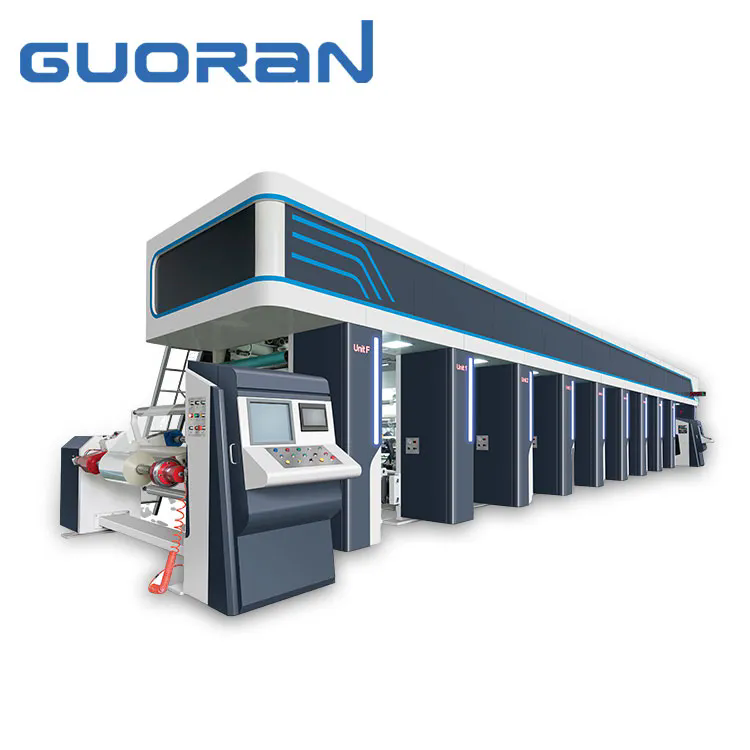Benefits and Applications of Gravure Printing Machine
2024-07-25
A gravure printing machine is a high-quality printing technology used for producing large volumes of high-resolution prints with exceptional color fidelity and detail. Gravure printing is often employed for printing packaging materials, magazines, catalogs, and other high-end products. Here’s a comprehensive overview of gravure printing machines:
Features
1. Printing Process:
- Rotogravure: Gravure printing, also known as rotogravure, uses engraved copper or steel cylinders to transfer ink onto the substrate. The cylinders have cells that hold the ink, and the image is transferred to the paper or other material through a pressing process.
- Ink Transfer: The engraved cylinders are dipped in ink, and excess ink is wiped off, leaving ink only in the cells. The substrate then presses against the cylinder, transferring the ink onto it.
2. Cylinder Types:
- Chrome-Plated Cylinders: Durable and suitable for long runs, often used in high-volume production.
- Copper-Plated Cylinders: Traditionally used, but less common today due to advancements in cylinder technology.
3. Print Quality:
- High Resolution: Capable of producing high-resolution images with smooth gradients and fine details.
- Color Consistency: Delivers consistent color reproduction, making it ideal for projects requiring precise color matching.
4. Ink System:
- Solvent-Based Inks: Traditionally used in gravure printing; these inks evaporate quickly and provide vibrant colors.
- Water-Based Inks: Increasingly used due to environmental regulations, providing lower VOC emissions and improved sustainability.
5. Web Handling:
- Continuous Feed: Typically operates with a continuous roll of substrate, allowing for efficient and high-speed printing.
- Tension Control: Advanced web handling systems manage the tension of the substrate to ensure consistent print quality.
Benefits
1. High-Quality Prints:
- Exceptional Detail: Capable of producing high-quality prints with fine detail and sharpness.
- Vibrant Colors: Delivers vibrant and accurate color reproduction, making it ideal for high-end packaging and publications.
2. Efficient Production:
- High Speed: Suitable for high-speed production, making it efficient for large print runs.
- Continuous Printing: Allows for continuous operation with minimal downtime, increasing productivity.
3. Durability:
- Long-Lasting Cylinders: Gravure cylinders are durable and can withstand extensive use, making them suitable for long print runs.
4. Versatility:
- Various Substrates: Capable of printing on a wide range of substrates, including paper, film, foil, and specialty materials.
Applications
1. Packaging:
- Flexible Packaging: Used for printing on flexible packaging materials such as plastic films, pouches, and wraps.
- Labels and Wrappers: Produces high-quality labels and wrappers for consumer goods.
2. Publishing:
- Magazines and Catalogs: Ideal for printing high-quality magazines, catalogs, and other publications requiring detailed images and vibrant colors.
3. Commercial Printing:
- Posters and Banners: Suitable for producing large-format prints with high resolution and color accuracy.
4. Specialty Products:
- Decorative Films: Used in producing decorative films and laminates for various applications.
Considerations
1. Cost:
- Initial Investment: Gravure printing machines can be expensive due to the cost of cylinders and the complexity of the machinery.
- Running Costs: Includes costs for inks, cylinders, and maintenance.
2. Setup and Maintenance:
- Cylinder Preparation: Requires precise engraving of cylinders, which can be time-consuming and costly.
- Maintenance: Regular maintenance is needed to ensure optimal performance and prevent downtime.
3. Environmental Impact:
- Ink Handling: Traditional solvent-based inks can have environmental and health impacts, so consider the use of water-based inks and proper disposal methods.
4. Print Run Length:
- Economical for Long Runs: Gravure printing is most cost-effective for long print runs due to the setup and cylinder costs. It may not be as economical for short runs compared to other printing methods.
Conclusion
Gravure printing machines are renowned for their ability to produce high-quality, detailed, and vibrant prints efficiently. They are widely used in packaging, publishing, and commercial printing applications. While the initial investment and setup can be substantial, the benefits of high-speed production, durability, and exceptional print quality make gravure printing a preferred choice for many high-volume printing projects. Proper consideration of cost, setup, and environmental impact is essential for optimizing the use of gravure printing technology.



